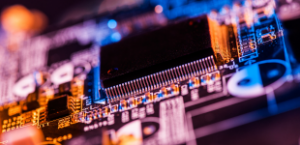The modern world is dominated by state-of-the-art technologies that we encounter in virtually every sphere of life. It is hard to imagine our daily lives without phones, laptops or other common electronic devices.
The electronics industry encompasses fields such as consumer electronics, telecommunications, power systems, computers, medical technology, industrial automation and many others. Its growth is driven by the ever-increasing demand for various types of devices that make our daily lives easier. In addition, the rapid development of process automation and the use of Internet resources or artificial intelligence make electronics increasingly ubiquitous, and their development and production must keep pace with the current needs of the society.

One of the pillars of advanced electronics is high-quality chemical raw materials and intermediate products dedicated to modern manufacturing technologies and the innovative electronic devices for which they are essential. Among other things, the chemicals enable the production of components that improve the performance and reliability of electronic devices. In addition, they allow the production of electronic devices and products in accordance with the principles of sustainable development.
The electronics industry uses a wide variety of chemical raw materials and intermediate products in its manufacturing processes. Among the most commonly used are:
Modern electronic devices require components based on high-quality raw materials that provide them with the required properties and will allow them to meet the expectations of consumers. Among the raw materials that currently play a key role in the electronics industry, there are ultrapure silicon trichloride and tetraethoxysilane (TEOS).
Ultrapure silicon trichloride is an excellent precursor used in the process of chemical vapour deposition (CVD) of silicon layers. It is used in the production of semiconductor layers, which are essential for the manufacture of microprocessors, integrated circuits and other electronic components. The use of silicon trichloride in this process allows for controlled and homogeneous deposition of layers, which is crucial for the structural and electrical properties of the finished components. This material also works well in photovoltaic applications.
Tetraethoxysilane, also known as TEOS, is the second key chemical raw material used in the electronics industry. It is an organic silicon compound that is used to deposit protective dielectric layers on silicon wafers. These layers provide electrical insulation between the various layers of integrated circuits and protect them from external factors such as moisture and contamination. Like silicon trichloride, TEOS is used in the CVD process. The properties of tetraethoxysilane allow the formation of layers with the required insulating properties, appropriate thickness and uniformity.
The use of silicon trichloride and tetraethoxysilane in the electronics industry highlights the importance of chemical raw materials as key elements for the development of advanced technologies. Thanks to these raw materials, manufacturers are able to create efficient and reliable electronic components that are essential to the industry and the society.
The modern world is dominated by state-of-the-art technologies that we encounter in virtually every sphere of life. It is hard to imagine our daily lives without phones, laptops or other common electronic devices.
An optical fibre is a wire made of plastics and glass fibre. It enables sending data using light waves at speeds reaching several terabits per second.
The car care market has been one of the most dynamically developing industries for years – both nationwide and globally. At the same time, Auto Care is an extremely extensive industry, including both ready-made preparations for removing dirt from vehicles and their maintenance, as well as components, additives and active agents used to create professional car cleaning and care detergents.